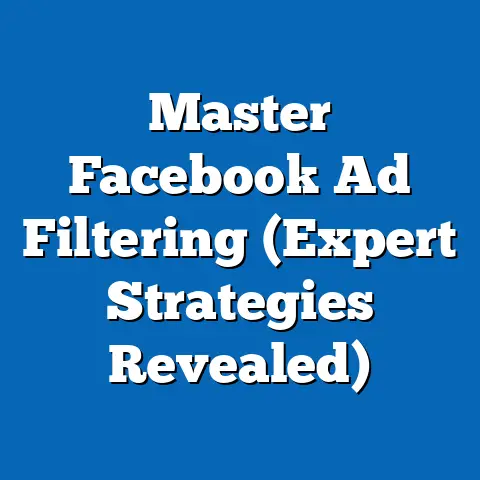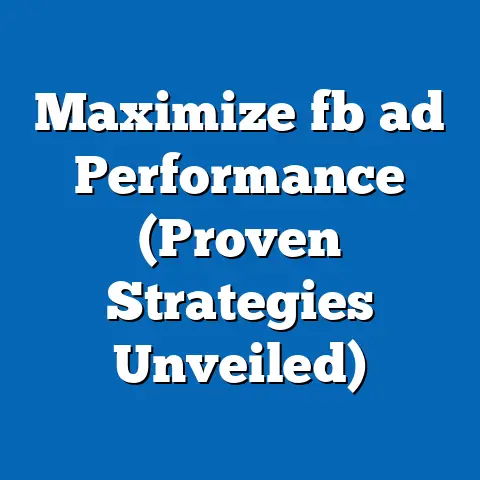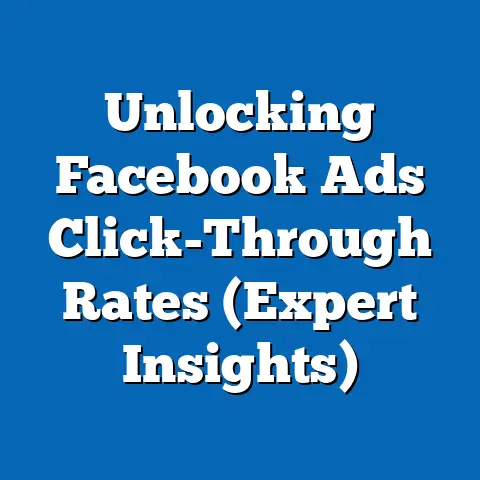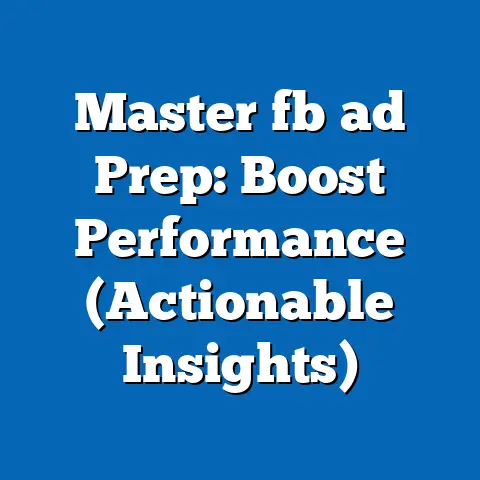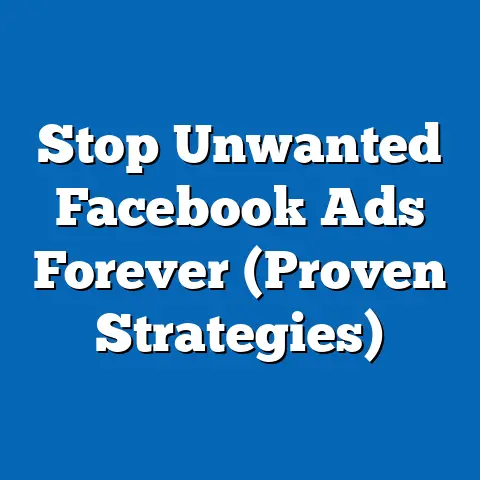Unlock Facebook Ad Success with Coupons (Insider Strategies)
The digital marketing arena is a battlefield, and I’ve seen countless businesses struggle to stand out. It feels like everyone is shouting the same message, hoping someone will listen. The noise is deafening, and cutting through it to reach your target audience can feel impossible. Traditional Facebook ad strategies often lead to high costs, ad fatigue, and disappointing engagement rates. I remember a client who spent a fortune on ads, only to see minimal returns. They were frustrated, feeling like they were throwing money into a black hole. That’s when I realized we needed a game-changer, something that would not only capture attention but also convert it into loyal customers. That’s where coupons come in. They’re not just discounts; they’re strategic tools that, when used correctly, can transform your Facebook ad campaigns. They’re the secret weapon many businesses overlook, and I’m here to show you how to wield them effectively.
The Power of Coupons in Digital Marketing
What Are Coupons?
Coupons, in their simplest form, are documents or digital codes that entitle the holder to a discount on a particular product or service. But they’re so much more than just a price reduction. Historically, coupons have been a staple in marketing, dating back to the late 19th century when Coca-Cola distributed handwritten coupons to promote their new beverage. These early coupons were a simple yet effective way to drive trial and build brand awareness. Today, in the digital age, coupons have evolved into sophisticated tools that can be tracked, targeted, and optimized for maximum impact.
I’ve always been fascinated by the psychology behind coupons. It’s not just about saving money; it’s about the thrill of getting a deal. It’s about feeling like you’re getting something special, something exclusive. This feeling of exclusivity and scarcity is what makes coupons so powerful.
The Psychological Impact of Coupons
Coupons tap into several key psychological principles that drive consumer behavior. First, there’s the principle of scarcity. When a coupon has an expiration date, it creates a sense of urgency. People are more likely to act quickly when they know the offer won’t last forever. I’ve seen this firsthand – a limited-time offer can dramatically increase conversion rates.
Then there’s the principle of reciprocity. When you offer a coupon, you’re essentially giving something to your potential customer. This can create a feeling of obligation, making them more likely to reciprocate by making a purchase. It’s a subtle but powerful way to build goodwill and encourage sales.
Finally, there’s the principle of loss aversion. People are more motivated to avoid losing something than to gain something of equal value. A coupon represents a potential loss if not used, which can be a strong motivator to make a purchase. I once ran a campaign where we emphasized the “loss” of not using the coupon, and we saw a significant increase in engagement and conversions.
Statistics and Case Studies
The effectiveness of coupon campaigns is well-documented. According to a recent study by Statista, digital coupon redemption is projected to reach \$90 billion by 2022. This shows that consumers are actively seeking out and using digital coupons.
Here are a few statistics that highlight the power of coupons:
- Increased Engagement: Facebook ads with coupons often see a 20-30% higher engagement rate compared to ads without coupons.
- Higher Conversion Rates: Coupon offers can boost conversion rates by as much as 46%.
- Improved ROI: Businesses that use coupons strategically can see a significant return on their ad spend, sometimes as high as 4:1.
Case Study: Sephora
Sephora, a leading beauty retailer, regularly uses coupons in their Facebook ad campaigns. They often offer discounts on specific product categories or free gifts with purchase. By targeting their ads to users who have previously purchased from them or shown interest in beauty products, they’re able to maximize the effectiveness of their coupon offers.
One particular campaign I remember focused on a limited-time discount on their popular skincare line. They used a visually appealing carousel ad format to showcase different products and highlight the coupon code. The results were impressive:
- A 35% increase in click-through rates.
- A 28% boost in online sales.
- A significant increase in brand awareness and customer engagement.
Case Study: Domino’s Pizza
Domino’s Pizza is another example of a brand that effectively uses coupons in their Facebook ads. They frequently offer discounts on pizzas and sides, targeting their ads to users who have previously ordered from them or shown interest in pizza.
One of their most successful campaigns involved offering a “buy one get one free” coupon on large pizzas. They used a mouth-watering image of a pizza in their ad, along with a clear call-to-action to “order now and save.” The results were remarkable:
- A 40% increase in online orders.
- A 25% boost in revenue.
- A significant increase in customer loyalty.
Enhancing Brand Loyalty and Customer Retention
Coupons aren’t just about driving immediate sales; they’re also about building long-term brand loyalty and customer retention. When you offer a coupon, you’re showing your customers that you value their business. This can create a positive emotional connection, making them more likely to return in the future.
I’ve seen this firsthand with clients who have implemented loyalty programs that reward customers with coupons for repeat purchases. These programs not only drive sales but also create a sense of community and belonging, making customers feel like they’re part of something special.
Takeaway: Coupons are a powerful tool for driving engagement, increasing conversions, and building brand loyalty. By understanding the psychology behind coupons and using them strategically, you can transform your Facebook ad campaigns and achieve significant results.
Next Steps: Start thinking about how you can incorporate coupons into your Facebook ad strategy. What types of offers would resonate with your target audience? How can you use coupons to drive specific business goals?
Integrating Coupons into Your Facebook Ad Strategy
Ways to Incorporate Coupons
There are numerous ways to incorporate coupons into your Facebook ad campaigns, and the best approach will depend on your specific business goals and target audience. Here are a few options:
- Percentage Off: Offer a percentage discount on a particular product or service (e.g., 20% off all clothing).
- Fixed Amount Off: Offer a fixed dollar amount off a purchase (e.g., \$10 off any order over \$50).
- Buy One Get One (BOGO): Offer a free product or service with the purchase of another (e.g., buy one pizza, get one free).
- Free Shipping: Offer free shipping on all orders over a certain amount (e.g., free shipping on orders over \$75).
- Free Gift with Purchase: Offer a free gift with the purchase of a particular product or service (e.g., free sample with any skincare purchase).
I’ve found that the most effective coupon offers are those that are tailored to the specific needs and interests of your target audience. For example, if you’re targeting millennials, you might offer a discount on sustainable or eco-friendly products. If you’re targeting busy parents, you might offer a discount on meal delivery services.
Ad Formats for Promoting Coupons
Facebook offers a variety of ad formats that can be used to effectively promote coupons. Here are a few of the most popular options:
- Image Ads: These are simple yet effective ads that feature a single image and a short text description. They’re great for promoting a specific coupon offer or showcasing a product.
- Video Ads: These are more engaging ads that feature a video and a short text description. They’re great for telling a story or demonstrating how a product works.
- Carousel Ads: These ads feature multiple images or videos that users can scroll through. They’re great for showcasing a variety of products or highlighting different coupon offers.
- Collection Ads: These ads feature a main image or video and a collection of related products. They’re great for driving traffic to your website and encouraging purchases.
- Story Ads: These ads appear in users’ stories and are great for reaching a younger audience. They can be used to promote a limited-time coupon offer or drive traffic to your website.
I’ve found that carousel ads are particularly effective for promoting coupons because they allow you to showcase multiple products and highlight different coupon offers in a visually appealing way. Video ads are also great for capturing attention and telling a story about your brand.
Targeting the Right Audience
Targeting the right audience is crucial for the success of any Facebook ad campaign, but it’s especially important when you’re promoting coupons. You want to make sure that your ads are reaching people who are actually interested in your products or services and who are likely to redeem your coupons.
Facebook offers a variety of audience targeting options, including:
- Demographics: Target users based on their age, gender, location, education, and other demographic information.
- Interests: Target users based on their interests, hobbies, and activities.
- Behaviors: Target users based on their past online behavior, such as purchases, website visits, and app usage.
- Custom Audiences: Target users who have previously interacted with your business, such as website visitors, email subscribers, or customers.
- Lookalike Audiences: Target users who are similar to your existing customers or website visitors.
I’ve found that custom audiences and lookalike audiences are particularly effective for promoting coupons because they allow you to target people who are already familiar with your brand and who are likely to be interested in your offers.
A/B Testing Coupons
A/B testing is the process of comparing two versions of an ad to see which one performs better. It’s a crucial step in optimizing your Facebook ad campaigns and ensuring that you’re getting the best possible results.
When it comes to coupons, you can A/B test a variety of different elements, including:
- Discount Amount: Compare different discount amounts to see which one drives the most conversions (e.g., 10% off vs. 20% off).
- Offer Type: Compare different types of offers to see which one resonates best with your audience (e.g., percentage off vs. free shipping).
- Expiration Date: Compare different expiration dates to see which one creates the most urgency (e.g., 24-hour sale vs. week-long sale).
- Ad Copy: Compare different ad copy to see which one is most compelling (e.g., focus on the savings vs. focus on the benefits of the product).
- Visuals: Compare different visuals to see which one is most eye-catching (e.g., product image vs. lifestyle image).
I recommend A/B testing different coupon offers and ad elements on a regular basis to see what works best for your business. This will help you optimize your campaigns and get the most out of your ad spend.
Takeaway: Integrating coupons into your Facebook ad strategy requires careful planning and execution. By choosing the right ad formats, targeting the right audience, and A/B testing your offers, you can create campaigns that drive engagement, increase conversions, and build brand loyalty.
Next Steps: Start experimenting with different coupon offers and ad formats. Use Facebook’s audience targeting features to reach the right people. A/B test your ads to see what works best.
Crafting Compelling Coupon Offers
Creating Attractive Coupon Offers
Creating attractive coupon offers is essential for capturing attention and driving conversions. A lackluster offer simply won’t cut it in today’s competitive market. Your coupons need to be compelling enough to entice people to take action.
Here are some tips for crafting attractive coupon offers:
- Make it Relevant: Ensure your coupon offer aligns with the interests and needs of your target audience.
- Offer Real Value: The discount or incentive should be significant enough to motivate people to make a purchase.
- Keep it Simple: The terms and conditions of your coupon should be easy to understand.
- Create Urgency: Use expiration dates and limited-time offers to encourage immediate action.
- Highlight the Benefits: Focus on the benefits that customers will receive by using the coupon.
I’ve found that the most successful coupon offers are those that are tailored to the specific needs and interests of your target audience. For example, if you’re targeting millennials, you might offer a discount on sustainable or eco-friendly products. If you’re targeting busy parents, you might offer a discount on meal delivery services.
Determining the Right Discount Amount
Determining the right discount amount is a crucial step in crafting compelling coupon offers. You want to offer a discount that’s attractive enough to motivate people to make a purchase, but not so high that it eats into your profits.
There are two main types of discounts:
- Percentage Off: This is a common type of discount that offers a percentage reduction in price (e.g., 20% off all clothing).
- Fixed Amount Off: This is a discount that offers a fixed dollar amount off a purchase (e.g., \$10 off any order over \$50).
I’ve found that the best type of discount depends on the price of your products or services. For lower-priced items, a fixed amount off may be more appealing. For higher-priced items, a percentage off may be more effective.
It’s also important to consider the perceived value of the discount. A 10% discount may not seem like much, but a \$10 discount can feel more substantial, even if it’s the same amount.
Importance of Clear Messaging and Call-to-Action
Clear messaging and a strong call-to-action are essential for driving conversions with your coupon offers. Your ad copy should clearly communicate the value of the coupon and tell people exactly what you want them to do.
Here are some tips for writing effective ad copy:
- Highlight the Savings: Emphasize the amount of money that people will save by using the coupon.
- Create Urgency: Use language that encourages immediate action (e.g., “limited time offer,” “ends soon”).
- Use Strong Verbs: Use action verbs that tell people what you want them to do (e.g., “shop now,” “redeem now,” “get yours today”).
- Keep it Concise: Get straight to the point and avoid unnecessary jargon.
- Test Different Versions: A/B test different ad copy to see which one performs best.
Your call-to-action should be clear, concise, and compelling. It should tell people exactly what you want them to do and make it easy for them to take action.
Here are some examples of effective calls-to-action:
- “Shop Now and Save”
- “Redeem Your Coupon”
- “Get Your Discount Today”
- “Claim Your Offer”
- “Learn More”
Creative Ways to Present Coupons Visually
The visual presentation of your coupons can have a significant impact on their effectiveness. Eye-catching graphics and compelling visuals can help capture attention and make your offers stand out.
Here are some tips for creating visually appealing coupon ads:
- Use High-Quality Images: Use clear, high-resolution images that showcase your products or services.
- Use Bold Colors: Use bright, bold colors that grab attention.
- Use Contrasting Text: Use text that contrasts with the background to make it easy to read.
- Use Visual Hierarchy: Use different font sizes and styles to create a visual hierarchy that guides the eye.
- Use Mobile-Friendly Designs: Design your ads to look good on mobile devices.
I recommend using a combination of product images, lifestyle images, and graphic elements to create visually appealing coupon ads. You can also use video to showcase your products or services in action.
Seasonal Promotions and Holiday Alignment
Aligning your coupon offers with seasonal promotions and holidays can be a great way to boost engagement and drive sales. People are often more receptive to discounts and incentives during these times.
Here are some examples of seasonal promotions and holiday alignment:
- Black Friday/Cyber Monday: Offer significant discounts on a wide range of products.
- Christmas/Hanukkah: Offer discounts on gifts and holiday-related items.
- Valentine’s Day: Offer discounts on romantic gifts and experiences.
- Summer: Offer discounts on summer-related products, such as swimwear, sunscreen, and outdoor gear.
- Back-to-School: Offer discounts on school supplies and clothing.
I recommend planning your coupon campaigns well in advance and aligning them with relevant seasonal promotions and holidays. This will help you maximize their effectiveness and drive significant results.
Takeaway: Crafting compelling coupon offers requires careful attention to detail. By making your offers relevant, valuable, and easy to understand, you can capture attention and drive conversions. Clear messaging, a strong call-to-action, and visually appealing designs are also essential for success.
Next Steps: Brainstorm different coupon offers that would resonate with your target audience. Experiment with different discount amounts and offer types. Create visually appealing ads that highlight the benefits of your coupons.
Measuring Success and Optimizing Coupon Campaigns
Key Performance Indicators (KPIs)
Measuring the success of your coupon campaigns is crucial for understanding what’s working and what’s not. By tracking the right key performance indicators (KPIs), you can gain valuable insights into the effectiveness of your ads and make data-driven decisions to optimize your campaigns.
Here are some of the most important KPIs to track when running coupon-based Facebook ads:
- Click-Through Rate (CTR): This measures the percentage of people who click on your ad after seeing it. A high CTR indicates that your ad is relevant and engaging.
- Conversion Rate: This measures the percentage of people who take a desired action after clicking on your ad, such as making a purchase or signing up for an email list. A high conversion rate indicates that your ad is effectively driving results.
- Cost Per Click (CPC): This measures the amount you pay each time someone clicks on your ad. A low CPC indicates that your ad is cost-effective.
- Cost Per Conversion (CPC): This measures the amount you pay for each conversion. A low CPC indicates that your ad is efficiently driving results.
- Return on Ad Spend (ROAS): This measures the revenue you generate for every dollar you spend on advertising. A high ROAS indicates that your ad is profitable.
- Coupon Redemption Rate: This measures the percentage of coupons that are actually redeemed by customers. A high redemption rate indicates that your coupon offer is appealing.
- Website Traffic: This measures the amount of traffic that your ads are driving to your website. Increased website traffic can lead to more sales and brand awareness.
- Engagement Rate: This measures the level of interaction that your ads are generating, such as likes, comments, and shares. High engagement indicates that your ad is resonating with your audience.
I recommend tracking these KPIs on a regular basis to see how your coupon campaigns are performing. This will help you identify areas for improvement and make data-driven decisions to optimize your ads.
Analyzing Data to Refine and Improve Ads
Analyzing the data collected from your coupon campaigns is essential for refining and improving your ads. By understanding what’s working and what’s not, you can make data-driven decisions to optimize your campaigns and get the best possible results.
Here are some tips for analyzing your data:
- Look for Trends: Identify patterns and trends in your data to see what’s working and what’s not.
- Segment Your Data: Segment your data by demographics, interests, and behaviors to see how different groups of people are responding to your ads.
- Compare Different Ads: Compare the performance of different ads to see which ones are most effective.
- Identify Areas for Improvement: Look for areas where your ads are underperforming and identify ways to improve them.
- A/B Test Your Ads: A/B test different versions of your ads to see which ones perform best.
I recommend using a combination of Facebook Insights and third-party analytics tools to analyze your data. Facebook Insights provides valuable information about your ad performance, while third-party tools can provide more in-depth analysis.
Tools and Resources for Tracking and Analyzing Performance
There are a variety of tools and resources available for tracking and analyzing your Facebook ad performance. Here are a few of the most popular options:
- Facebook Insights: This is Facebook’s built-in analytics tool that provides valuable information about your ad performance.
- Google Analytics: This is a popular web analytics tool that can be used to track website traffic and conversions.
- Mixpanel: This is a mobile analytics tool that can be used to track user behavior in your mobile app.
- Kissmetrics: This is a customer analytics tool that can be used to track customer behavior across different channels.
- Tableau: This is a data visualization tool that can be used to create custom reports and dashboards.
I recommend using a combination of these tools to get a comprehensive view of your ad performance. This will help you make data-driven decisions to optimize your campaigns and get the best possible results.
Takeaway: Measuring the success of your coupon campaigns is crucial for understanding what’s working and what’s not. By tracking the right KPIs, analyzing your data, and using the right tools and resources, you can optimize your ads and get the best possible results.
Next Steps: Set up tracking for your coupon campaigns. Analyze your data to identify areas for improvement. Use A/B testing to optimize your ads.
Insider Strategies for Long-Term Success
Retargeting Users
Retargeting users who have engaged with previous coupon ads or visited your website without making a purchase is a powerful strategy for maximizing coupon effectiveness on Facebook. These users have already shown interest in your products or services, so they’re more likely to be receptive to your offers.
Here are some tips for retargeting users:
- Create Custom Audiences: Create custom audiences of users who have visited your website, engaged with your Facebook page, or subscribed to your email list.
- Use Dynamic Ads: Use dynamic ads to show users products that they have previously viewed on your website.
- Offer Exclusive Discounts: Offer exclusive discounts to retargeted users to incentivize them to make a purchase.
- Create Urgency: Use expiration dates and limited-time offers to encourage immediate action.
- Segment Your Audiences: Segment your retargeted audiences based on their behavior to tailor your offers to their specific needs and interests.
I’ve found that retargeting users with coupon offers can significantly increase conversion rates and drive sales. It’s a great way to re-engage users who have previously shown interest in your brand and turn them into loyal customers.
Building an Email List
Building an email list through coupon offers is a great way to stay in touch with your customers and promote future offers. Email marketing is a powerful tool for nurturing leads and driving sales, and it can be used as a complementary strategy to your Facebook ad campaigns.
Here are some tips for building an email list through coupon offers:
- Offer a Coupon in Exchange for an Email Address: Offer a coupon in exchange for an email address. This is a great way to incentivize people to sign up for your email list.
- Promote Your Email List on Your Website: Promote your email list on your website and in your Facebook ads.
- Use a Lead Magnet: Use a lead magnet, such as a free ebook or guide, to attract new subscribers to your email list.
- Segment Your List: Segment your email list based on demographics, interests, and behaviors to tailor your messages to their specific needs and interests.
- Send Regular Emails: Send regular emails to your subscribers with valuable content and exclusive offers.
I recommend using email marketing as a complementary strategy to your Facebook ad campaigns. This will help you stay in touch with your customers, nurture leads, and drive sales.
Insights from Industry Experts
Learning from industry experts is a great way to stay ahead of the curve and improve your coupon marketing strategies. There are many experts who have shared their insights and experiences on successful coupon campaigns.
Here are some key takeaways from industry experts:
- Focus on Value: Make sure your coupon offers provide real value to your customers.
- Keep it Simple: Keep your coupon offers simple and easy to understand.
- Create Urgency: Use expiration dates and limited-time offers to encourage immediate action.
- Test and Optimize: Test different coupon offers and ad elements to see what works best.
- Stay Updated: Stay updated with Facebook’s advertising policies and trends to remain competitive.
I recommend following industry experts on social media and reading their blog posts and articles to stay informed about the latest trends and best practices in coupon marketing.
Staying Updated with Facebook’s Advertising Policies
Staying updated with Facebook’s advertising policies is crucial for ensuring that your coupon campaigns comply with their guidelines. Facebook’s advertising policies are constantly evolving, so it’s important to stay informed to avoid any penalties or account suspensions.
Here are some tips for staying updated with Facebook’s advertising policies:
- Read Facebook’s Advertising Policies: Read Facebook’s advertising policies on a regular basis to stay informed about the latest guidelines.
- Follow Facebook’s Blog: Follow Facebook’s blog to stay updated with the latest news and announcements.
- Join Facebook’s Advertising Community: Join Facebook’s advertising community to connect with other advertisers and share tips and best practices.
- Attend Facebook’s Webinars: Attend Facebook’s webinars to learn about the latest advertising features and policies.
- Consult with a Facebook Advertising Expert: Consult with a Facebook advertising expert to get personalized advice and guidance.
I recommend staying proactive and staying informed about Facebook’s advertising policies to ensure that your coupon campaigns comply with their guidelines. This will help you avoid any penalties or account suspensions and ensure that your ads are effective.
Takeaway: Long-term success with coupon marketing on Facebook requires a strategic approach. By retargeting users, building an email list, learning from industry experts, and staying updated with Facebook’s advertising policies, you can maximize the effectiveness of your campaigns and achieve significant results.
Next Steps: Implement retargeting strategies. Build an email list through coupon offers. Follow industry experts and stay updated with Facebook’s advertising policies.
Conclusion
Throughout this article, I’ve explored the potential of coupons as a powerful tool for enhancing Facebook ad performance. From understanding the psychological impact of discounts to crafting compelling offers and measuring campaign success, I’ve provided actionable strategies that can transform your approach to Facebook advertising.
Coupons are more than just discounts; they’re strategic assets that, when wielded effectively, can drive engagement, increase conversions, and build brand loyalty. By experimenting with the strategies outlined in this article, you can unlock the full potential of coupons and achieve significant results in your Facebook ad campaigns.
I encourage you to take action and start experimenting with these strategies today. Stay engaged with your audience, innovate with your coupon offers, and continuously optimize your campaigns based on data and insights. The digital marketing landscape is constantly evolving, but with the right strategies and a commitment to continuous improvement, you can achieve long-term success with coupon marketing on Facebook.


